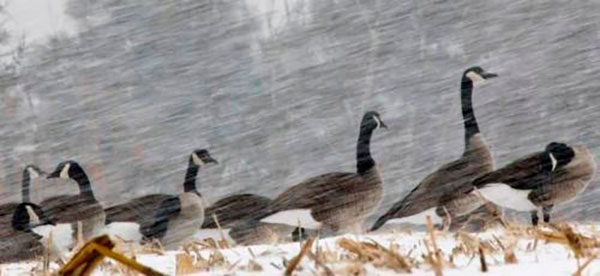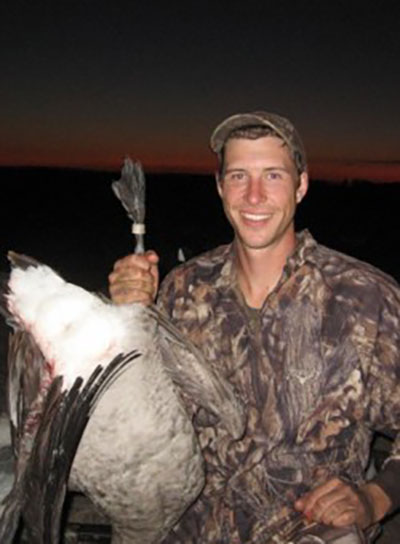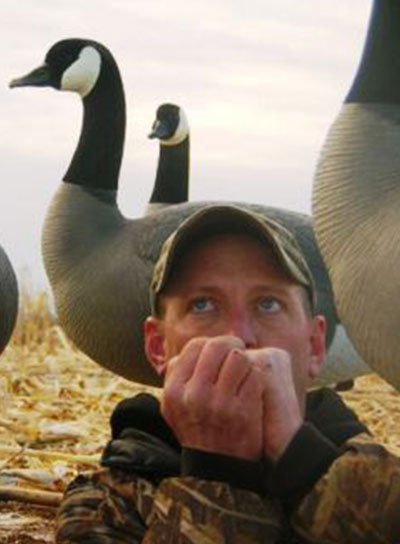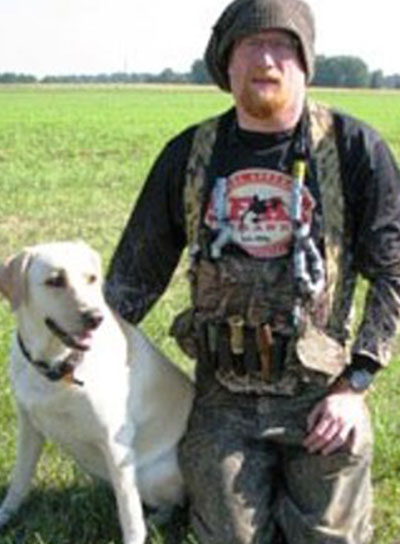How To Pattern Late Season Canada Geese
Patterning Late Season Canada Geese – Tips From The Pro’s
By dan wennerlind

It happens all too often in the late season, as the cold temps start to show up day after day, and then a warm spell hits. The geese seem to have their own ideas as to what times of the day they want to feed and many hunters are left guessing as to when they should set up and either end up staring at clear skies until they are frozen solid or show up to a field already full of geese already enjoying their meal. So the question is commonly asked “How Do You Pattern Late Season Canada Geese”?
I had a chance to interview several of the top Canada goose hunting outfitters across the country to compare their thoughts to my personal experiences and here is what I came up with-
Phil Schmidt – Goose Busters Guide Service
Phil Schmidt has been successfully guiding Canada goose hunters in Minnesota for over 9 years and in that time has become a student of the geese he loves to hunt. After speaking with Phil in-depth about goose hunting over the past several seasons, I am confident that Phil has figured out how to Pattern Late Season Canada Geese. Here are several of Phil’s theories on the subject-
- During the months of September and October in Minnesota the geese will usually feed 100% in the morning and 100% in the evening. However starting in late October to early November the birds switch to a once a day feeding schedule.
- On cold, clear days the birds will only feed once in the evening. That doesn’t mean a few birds won’t get up in the morning, as a few usually do out of habit, but it’s a weak flight (10% or less) and the birds are trading from water to water. The few birds that do this on the real cold mornings can still be decoyed and killed but they are not hungry and not very vulnerable to a field set up.

- Now let’s throw clouds in the mix. The birds will start feeding as soon as it gets cloudy. Not a few clouds… Not partly cloudy…. Not partly sunny…. Solid cloud cover is the best! On a day where its going to be solid cloud cover all day, the birds will still feed once a day but they will feed all day long and the hunting should be good all day. The day will probably consist of small random feed flights throughout the day of 10-30%. By the end of the day 100% of the area birds will have fed. On these days I like to get started early cause the sooner we start, the sooner we can be done.
- On days that start out cold and clear until noon let’s say and then the clouds roll in thick it is be set up and ready to hunt by 11:30. The geese may not start flying right when the clouds roll in but maybe they will, so be ready. I’ve seen it go both ways.
- Other important factors that come into play during late season hunting are the phase of the moon as well as storm fronts. Those topics are in-depth in their own right, but cloud cover is one of the main areas that will change the birds feeding patterns, so stop freezing your butt off looking at empty skies and go knock the snot out of’em!
Jeff Colwell – Front Range Guide Service

Jeff Colwell has been hunting and guiding goose hunters from Denver to Fort Collins, Colorado since he can remember. Jeff sees large numbers of staging geese in the 200,000 – 250,000 range in his region come late season. In addition he also has a good mixture of both the greater Canada geese and the lesser cackler geese that they contend with through most of his late season hunts. Jeff offered these tips for late season Canada goose hunting-
- When hunting greater Canadas later in the year that are staging in large concentrations Jeff likes to use smaller spreads and spread them out making his set-up more relaxed and inviting.
- When hunting the smaller, cackler geese Jeff still likes big decoy spreads with a lot of flagging and calling to bring the smaller geese into gunning range.
- Jeff states that later in the season the birds will shift to an afternoon only feeding mode. When this happens Jeff likes to hunt water / ice in the morning for those birds that are moving to and from water early and then move to the grain fields in the afternoon if needed.
- Jeff also notes that weather always plays a big role in goose hunting and warmer weather means birds trading earlier, while cold conditions find birds being lazy and feeding later in the day.
- Jeff has also found that in warm spells the geese may switch their feeding patterns to greens, like winter wheat and grasses, where in cold weather they need the high carbs of the corn.
- Jeff advises to always be ready on high wind days as the birds will fly early, even when it is cold. Jeff says they have learned that lesson the hard way but paying attention to the way the birds act in different situations in late season is the main key to shooting geese consistently. It will definitely make you a better, more efficient hunter.
Shawn Eldredge – Prairies Edge
Shawn Eldredge “The Goose Guru” has been hunting Canada geese and guiding hunters since the 80’s. Shawn has guided hunters in Minnesota, Iowa and Missouri. He now spends most of his time guiding goose hunters around the Squaw Creek NWR in northwest Missouri as well as in West Des Moines, Iowa each year. Shawn has found the following tactics to be helpful as the geese are hunted harder as the season progresses later in the year-
- Scouting is of the utmost importance come late season. It may seem like it should go without saying but to be successful later in the year, keeping on top of the birds is a must as roost ponds are freezing up and new birds are moving in and out of the area frequently.
- When snow and ice hit the ground all species of geese (Snows, Specks and Canadas) can be very challenging to pattern. When they do get a warm day late in the season, Shawn likes to rearrange his spreads back into family groups when hunting the dark geese, which will pull the smaller flocks trading back and forth into gunning range.

- Shawn also studies the geese and says after 2 or 3 flocks ignore his calling he figures they may not want to hear anything that day and shuts up! He may hit them with a single honk on the corners but will keep the calling to a minimum when the birds dictate that’s what they want.
- Shawn also says that when the snow hits the ground he may go back to some of his early season fields, late in the year, as trafficing fields to pull birds into his spreads that are feeding nearby.
Dan Wennerlind – Founder Of HuntTheNorth.com

For every hunter there is the specific setting that they enjoy more than anything. For me it is watching a flock of Canada geese locked up, wings set and committed to the spread. That is the passion that drove me into the sport of hunting and motivated me to start the HuntTheNorth.com service. Over the years of trial and error and spending countless hours in the truck scouting, as well studying geese in the field, I too have identified several “Rules Of Thumb” for hunting late season Canada geese that I would like to share-
- When the temps are below 40 degrees I hunt like to hunt corn, but when temps are above 40 degrees it is important to watch and know what other grain fields the birds may have available and will most likely switch over to.
- I have also found that the colder the day, the later the birds will fly, if no storm fronts are moving in. I have seen geese only feed for the last half hour of the day when the temps drop down into the teens.
- I always keep an eye on the roost! As the lakes start to freeze up the birds will change roosts to find open water. And hunting the roost late in the season is a sure way to blow the birds out of the area.
- When a storm front is moving in all bets are off. The birds may go into a frantic feed mode and feed hard all day long, but snow storms can be tricky as the birds may not fly at all depending on the situation. We have had some of our best hunts in blizzard type conditions and have been burned just as many times.
- On cold mornings I like to set up in the daylight as the birds usually won’t start flying until around 8:30 – 10:30 am. This also gives me time to check the roost pond first, to make sure the birds haven’t moved on us overnight and then set up in the light which is always easier. Also we are not frozen solid by the time the geese start flying.
- The best advice I can give is to spend as much time as is available to watch and patterns the birds each day leading up to a hunt. The more consistent the weather leading up to a hunt the more patternable the birds will be.
I hope these words of wisdom, from those who spend month after month in the field each fall have been helpful in helping to identify some different tactics and ways to “Pattern Late Season Canada Geese” for your next hunting adventure. By using some of the advice offered from these top professionals in the country we hope that your next late season goose hunt will be a great success. Please enjoy the experience and respect the game you hunt and introduce a youngster to the long tradition of ours that is waterfowl hunting!
Below is a listing of all of the exceptional waterfowl hunting outfitters that we represent through our service at HuntTheNorth.com, along with a breif description of the specific hunts they offer. One of the best ways I know how to get better at my passion of waterfowl hunting is spending time with others that are more experienced and have the same passion as I do. Feel free to call and talk with any of our Incredible Waterfowl Hunting Outfitters and book a hunt to not only have a great hunt, but to make a connection and a friend. Best of luck and I hope you enjoy the service that HuntTheNorth.com has to offer!
Huntthenorth.com’s Premier Waterfowl Hunting Adventures
At HuntTheNorth.com we have researched and hand-picked ONE Unique, Quality Waterfowl Hunting Adventure across many states in North America.
Here is a selection of our World Class Waterfowl Hunting Adventures
- OKLAHOMA- In Your Face Guided Duck And Wild Hog Combos
- ALASKA – World Class Trophy Sea Duck Hunts
- MINNESOTA – Field Canada Goose Hunts & Big Water Duck Hunts
- WISCONSIN – Canvasback & Diver Hunts On The Mississippi River
- MICHIGAN – Duck Hunts On Lake St. Clair
- NORTH DAKOTA – Prairie Pothole Duck Hunts / Goose Hunts
- SOUTH DAKOTA – Late Season Missouri River Canada Goose Hunts
- NEBRASKA – Mallard Hunts On The North Platte River
- MISSOURI – Field Duck / Goose Hunts Near The Squaw Creek NWR
- ILLINOIS – Flooded Corn Field Mallard And Canada Goose Hunts
- MARYLAND – Sea Duck Hunts On The Cheasapeake Bay
- COLORADO – Field Canada Goose Hunts / Water Duck Hunts
- WYOMING – Field Canada Goose And Duck Hunts
- WASHINGTON – Field Canada Goose And Mallard Hunts
- SASKATCHEWAN – Specklebelly / Snow Goose Field Hunts
- MANITOBA – Diver Duck Hunts On The Delta Marsh
- ALBERTA – Field Canada Goose Hunts For Giant Honkers
- MEXICO – Coastal Marsh Duck Hunts For Late Season Pintails, Teal & Other Ducks
